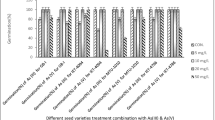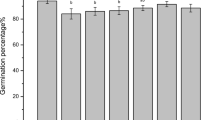Abstract
Elevated soil arsenic levels resulting from long-term use of arsenic contaminated ground for irrigation in Bangladesh may inhibit seed germination and seedling establishment of rice, the country's main food crop. A germination study on rice seeds and a short-term toxicity experiment with different concentrations of arsenite and arsenate on rice seedlings were conducted. Percent germination over control decreased significantly with increasing concentrations of arsenite and arsenate. Arsenite was found to be more toxic than arsenate for rice seed germination. There were varietal differences among the test varieties in response to arsenite and arsenate exposure. The performance of the dry season variety Purbachi was the best among the varieties. Germination of Purbachi was not inhibited at all up to 4 mg l−1 arsenite and 8 mg l−1 arsenate treatment. Root tolerance index (RTI) and relative shoot height (RSH) for rice seedlings decreased with increasing concentrations of arsenite and arsenate. Reduction of RTI caused by arsenate was higher than that of arsenite. In general, dry season varieties have more tolerance to arsenite or arsenate than the wet season varieties.
Similar content being viewed by others
References
Alam M B and Sattar M A 2000 Assessment of arsenic contamination in soils and waters in some areas of Bangladesh. Water Sci. Tech. 42, 185–193.
Baker A J M 1987 Metal tolerance. New Phytol. 106 (suppl.), 93–111.
BGS (British Geological Survey) 2000 Executive summary of the main report of Phase I, Groundwater Studies of Arsenic Contamination in Bangladesh, by British Geological Survey and Mott MacDonald (UK) for the Government of Bangladesh, Ministry of Local Government, Rural Development and Cooperatives, Department of Public Health Engineering, and Department for International Development (UK). (http://www.dainichiconsul. co.jp/engl ish/ article/DFID-sum.html).
Blanck H, Holmgren K, Lander L, Norin H, Notini M, Rosemarin A and Sundelin B 1989 Advanced hazard assessment of arsenic in Swedish environment. In Chemicals in the Aquatic Environment. Advanced Hazard Assessment. Ed. L Lander. pp 256–328. Spinger, Berlin.
Breed A W, Galtz A, Hansford G S and Harrison S T L 1996 The effect of As(III) and As(V) on the bioleaching of a pyritearsenopyrite concentrate. Miner. Eng. 9, 1235–1252.
Carbonell-Barrachina A A, Aarabi M A, DeLaune R D, Gambrell R P and Patrick W H Jr 1998 The influence of arsenic chemical form and concentration on Spartina patens and Spartina alterni-flora growth and tissue arsenic concentration. Plant Soil 198, 33–43.
Carbonell-Barrachina A A, Burlo F, Valero D, Lopez E, Martinez-Romero D and Martinez-Sanchez F 1999 Arsenic toxicity and accumulation in Turnip as affected by arsenic chemical speciation. J. Agric. Food Chem. 47, 2288–2294.
Carbonell Barrachina A, Burlo Carbonell F and Mataix Beneyto J 1995 Arsenic uptake, distribution, and accumulation in tomato plants: effect of arsenic on plant growth and yield. J. Plant Nutr. 18, 1237–1250.
Coddington K 1986 A review of arsenicals in biology. Toxicol. Environ. Chem. 11, 281–290.
Frans R, Horton D and Burdette L 1988 Influence of MSMA on straighthead, arsenic uptake and growth response in rice (Oryza sativa). Arkansas AES. Rep. Ser. 302, 1–12.
Hartley-Whitaker J, Ainsworth G and Meharg A A 2001 Copperand arsenate-induced oxidative stress in Holcus lanatus L. clones with differential sensitivity. Plant Cell Environ. 24, 713–722.
Jiang Q Q and Singh B R 1994 Effect of different forms and sources of arsenic on crop yield and arsenic concentration. Water Air Soil Pollut. 74, 321–343.
Kabata-Pendias A and Pendias H 1984 Trace Elements in Soils and Plants. CRC Press, Inc., Boca Raton, Florida, USA. 64 p.
Kapustka L A, Lipton J, Galbraith H, Cacela D and LeJeune K 1995 Metal and arsenic impacts to soils, vegetation communities and wildlife habitat in southwest Montana uplands contaminated by smelter emissions: II. Laboratory phytotoxicity studies. Environ. Toxicol. Chem. 14, 1905–1912.
Karataglis S S 1980 Zinc and copper effects on metal tolerant and non-tolerant clones of Agrostis tenuis. Plant Syst. Evol. 134, 173–182.
Knauer K, Behra R and Hemond H 1999 Toxicity of inorganic and methylated arsenic to algal communities from lakes along an arsenic contamination gradient. Aquatic Toxicol. 46, 221–230.
Liebig-Jr G P 1966 Arsenic. In Diagnostic Criteria for Plants and Soils. Ed. H D Chapman. pp 13–23. University of California, Division of Agricultural Science, Riverside, CA.
Macnair M R, Cumbes Q J and Meharg A A 1992 The genetics of arsenate tolerance in Yorkshire fog, Holcus lanatus L. Heredity 69, 325–335.
Maitani T, Kubota H, Sato K and Yamada T 1996 The composition of metals bound to class III metallothioein (phytochelatin and its desglycyl peptide) induced by various metals in root cultures of Rubia tinctorum. Plant Physiol. 110, 1145–1150.
Marin A R, Masscheleyn P H and Patrick W H Jr 1992 The influence of chemical form and concentration of arsenic on rice growth and tissue arsenic concentration. Plant Soil 139, 175–183.
Marin A R, Masscheleyn P H and Patrick WH Jr 1993b Soil redoxpH stability of arsenic species and its influence on arsenic uptake by rice. Plant Soil 152, 245–253.
Marin A R, Pezeskhi S R, Masscheleyn P H and Choi H S 1993a Effect of dimethylarsenic acid (DMAA) on growth, tissue arsenic, and photosynthesis of rice plants. J. Plant Nutr. 16, 865–880.
Masscheleyn P H, Dlaune R D and Patrick W H Jr 1991 Effect of redox potential and pH on arsenic speciation and solubility in a contaminated soil. Environ. Sci. Technol. 25, 1414–1418.
Meharg A A and Macnair M R 1992b Suppression of the high affinity phosphate uptake system: A mechanism of arsenate tolerance in Holcus lanatus L. J. Exp. Bot. 43, 519–524.
Meharg A A 1994 Integrated tolerance mechanisms: constitutive and adaptive plant responses to elevated metal concentrations in the environment. Plant Cell environ. 17, 989–993.
Meharg A A and Macnair M R 1992a Polymorphism and physiology of arsenate tolerance in Holcus lanatus L. from an uncontaminated site. Plant Soil 146, 219–225.
Mylona P V, Polidoros A N and Scandalios J G 1998 Modulation of antioxidant responses by arsenic in maize. Free Radical Bio. Med. 25, 576–585.
Odanaka Y, Tsuchiya N, Matano O and Goto S 1987 Absorption, translocation and metabolism of the arsenical fungicides, iron methanearsonate and ammonium iron methanearsonate, in rice plants. J. Pesticide Sci. 12, 199–208.
Onken B M and Hossner L R 1995 Plant uptake and determination of arsenic species in soil solution under flooded conditions. J. Environ. Qual. 24, 373–381.
Onken B Mand Hossner L R 1996 Determination of arsenic species in soil solution under flooded conditions. Soil Sci. Soc. Am. J. 60, 1385–1392.
Paliouris G and Hutchinson T C 1991 Arsenic, cobalt and nickel tolerances in two populations of Silene vulgaris (Moench) Garcke from Ontario, Canada. New Phytol. 117, 449–459.
Pepper I, Galanti N, Sans J and Lopez-Saez J F 1988 Reversible inhibition of root growth and cell proliferation by pentavalent arsenic in Allium cepa L. Environ. Exp. Botany 28, 9–18.
Porter E K and Peterson P J 1977 Arsenic tolerance in grasses growing on mine waste. Environ. Pollut. 14, 255–265.
Rochette E A, Li G C and Fendorf S E 1998 Stability of arsenate minerals in soil under biotically generated reducing conditions. Soil Sci. Soc. Am. J. 62, 1530–1537.
Samanta G, Chowdhury T R, Mandal B K, Biswas B K, Chowdhury U-K, Basu G K, Chanda C R, Lodh D and Chakraborti D 1999 Flow injection hydride generation atomic absorption spectrometry for determination of arsenic in water and biological samples from arsenic-affected districts ofWest Bengal, India and Bangladesh. Microchem. J. 62, 174–191.
Schmöger M E V, Oven M and Grill E 2000 Detoxification of arsenic by phytochelatins in plants. Plant Physiol. 122, 793–801.
Sharples J M, Meharg A A, Chambers S M and Cairney J W G 2000 Mechanism of arsenate resistance in the Ericoid mycorrhizal fungus Hymenoscyphus ericae. Plant Physiol. 124, 1327–1334.
Sheppard S C 1992. Summary of phytotoxic levels of soil arsenic. Water Air Soil Poll. 64, 539–550.
Smith E, Naidu R and Alston A M 1998 Arsenic in the soil environment: a review. Advan. Agron. 64, 149–195.
Sneller E F C, Van Heerwaarden L M, Kraaijeveld-Smit F J L, Ten Bookum W M, Koevoets P L M, Schat H and Verkleij J A C 1999 Toxicity of arsenate in Silene vulgaris, accumulation and degradation of arsenate-induced phytochelatins. New Phytol. 144, 223–232.
Sneller E F C, Van Heerwaarden L M, Schat H and Verkleij J A C 2000 Toxicity, metal uptake, and accumulation of phytochelatins in Silene vulgaris exposed to mixtures of cadmium and arsenate. Environ. Toxicol. Chem. 19, 2982–2986.
Takamatsu T, Aoki H and Yoshida T 1982 Determination of arsenate, arsenite, monomethylarsonate, and dimethylarsinate in soil polluted with arsenic. Soil Sci. 133, 239–246.
Tang T and Miller D M 1991 Growth and tissue composition of rice grown in soil treated with inorganic copper, nickel, and arsenic. Commun. Soil Sci. Plant Anal. 22, 2037–2045.
Tsutsumi M 1980 Intensification of arsenic toxicity to paddy rice by hydrogen sulphide and ferrous iron I. Induction of bronzing and accumulation in rice by arsenic. Soil Sci. Plant Nutr. 26, 561–569.
Ullah S M 1998 Arsenic contamination of ground water and irrigated soils of Bangladesh. In Abstracts: International Conference on Arsenic Pollution of Ground Water in Bangladesh: Causes, Effects and Remedies, 8–12 February 1998, Dhaka Community Hospital, Dhaka, Bangladesh. 133p.
WHO 2001 Arsenic in drinking water URL:http://www.who.int/inffs/ en/fact210.h tml
Woolson E A 1973 Arsenic phytotoxicity and uptake in six vegetable crops. Weed Sci. 21, 524–527.
Yan-Chu H 1994 arsenic distribution in soils. In Arsenic in the Environment, part I Cycling and Characterization. Ed. J O Nriagu. pp 17–49. John Wiley & Sons, Inc., New York, USA.
Author information
Authors and Affiliations
Corresponding author
Rights and permissions
About this article
Cite this article
Abedin, M.J., Meharg, A.A. Relative toxicity of arsenite and arsenate on germination and early seedling growth of rice (Oryza sativa L.). Plant and Soil 243, 57–66 (2002). https://doi.org/10.1023/A:1019918100451
Issue Date:
DOI: https://doi.org/10.1023/A:1019918100451




